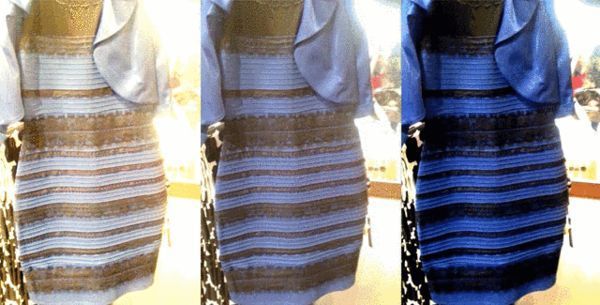当前位置: Language Tips> 双语新闻
Debate rages over color of dress photographed in rare light

This photo of a dress has caused an internet uproar: Is it blue and black, or white and gold?
这张照片让网友们吵翻天了,到底是"蓝+黑"还是"白+金"啊?
So far, according to Buzzfeed, about three-quarters of respondents see white and gold.
截止目前,Buzzfeed的投票显示,3/4的人认为这条裙子的颜色是"白+金"。
But why are people seeing such wildly different colors? First off, it’s not monitor settings.
为什么不同的人看到的颜色差别这么大?首先给显示屏洗脱冤屈吧。
It’s probably not about the cells in your eyes.
与视网膜细胞貌似没啥关系。
Our retinas have specialized cells called rods, which are used for night vision, and cones, which deal with color. But these cells are probably not the source of the dress dilemma.
视网膜中有视杆细胞,负责夜视,以及视锥细胞,负责颜色。但这些细胞并不能解释这条诡异的变色裙子。
Cones come in three types: red, blue, and green. And each of us has very different ratios of these types. But the different ratios "don’t seem to have a big impact on our color vision," said Cedar Riener, associate professor of psychology at Randolph-Macon College. "I could have a 5-1 ratio of red to green cones, and you could have 2-1, and we could both have similar color sensitivity."
伦道夫-麦肯学院心理学副教授Cedar Riener解释说,视锥细胞有三种形式:红、蓝、绿。不同的人眼睛中这三种形式的视锥细胞比率都不尽相同,但是这并不影响我们对颜色的认知。比如我可以有红:绿=5:1的视锥细胞,你的是2:1,但是我们看到的红和绿是类似的。
It’s about how your brain is interpreting the light coming into your eyes.
是你的大脑如何解释进入眼睛的光。
The dress phenomenon, according to neuroscientist Dale Purves of Duke University, "shows how strongly people are wedded to the idea that colors are properties of objects, when they are in fact made up by the brain."
杜克大学神经系统学家Dale Purves说这条诡异的裙子很好的说明了一个问题:"人们根深蒂固的坚信颜色是物体本身的属性,其实它们不过是大脑的解释罢了"。
OK, but why do different people’s brains interpret the light differently?
好吧,但是为什么每个人的大脑给出的解释都不一样呢?
Our vision is heavily influenced by so-called "top-down" processing, John Borghi, a cognitive neuroscientist at Rockefeller University, told BuzzFeed News. Top-down processing "begins with the brain and flows down, filtering information through our experience and expectations to produce perceptions."
洛克菲勒大学认知神经系统学家John Borghi解释了我们视觉形成的过程:视觉是一个从上向下的过程,从大脑开始,根据经验和预期向下过滤信息,直到产生视觉。
Each person brings a different set of experiences and expectations, as well as attention levels and particular eye movements.
每个人的经验和预期不同,关注程度以及眼球运动也不同。
For example, what you looked at just before you looked at the dress could influence the way your brain perceived it, Borghi added. "It could also be that you’ve seen dresses (or fabric) with the same texture or shape before, which could also affect your perception." This general phenomenon is called priming.
Borghi打了个比方,你看这条裙子前看了什么可能影响你看到这条裙子的颜色。"如果此前你看到过与这条裙子材质或形状相似的裙子(或织物),也可能影响你的视觉。"这叫启动效应。
Vocabulary
uproar:骚动、哗然
retina:视网膜
ratio:比例
neuroscientist:神经系统科学家
filter:过滤
phenomenon:现象
(来源:中国日报网双语新闻 编辑:张默)
上一篇 : 脸书账号可以被“继承”了
下一篇 : 全球首例男同性恋三人婚礼
关注和订阅


电话:8610-84883645
传真:8610-84883500
Email: languagetips@chinadaily.com.cn